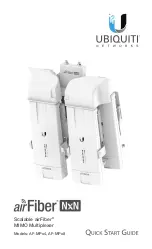
5-14 Issue 9 October 1998
363-206-204
Release 6 Installation Tests
1. Determine the fiber interconnections for a multispan system configuration.
Refer to Figure 5-3 and Figure 5-4.
2. Disconnect the optical loopback fibers from the OLIUs and connect the
transmission fibers to their predetermined OLIU connector.
3. Verify that the transmission cables are set up for normal operation.
4. After a few moments, verify that no alarms are present (other than the
BBG6 associated alarms as described below). If alarms are present, press
the UPD/INIT pushbutton on the SYSCTL. If alarms do not clear, refer to
the "Troubleshooting" section of this manual.
NOTE
:
If BBG6 (STS-1E) circuit packs are present ‘INC. EC-1 LOS’ alarms will
exist until EC-1 loopback connections are made as the BBG6 transmits an
internal test signal at all times. When EC-1 loopbacks are present, ‘INC.
STS/AIS’ alarms may exist at the far-end for low speed applications utiliz-
ing VT cross-connects.
5. Disconnect the fiber cable from the OUT jack on the Main-1 OLIU or Fn-1
OLIU (when provided) at one end of the span. At the other end, verify that
the appropriate OLIU FAULT LED is flashing, indicating loss of signal.
NOTE
:
Figures 5-3 and 5-4 show examples of multispan system configurations.
6. Reconnect the fiber and repeat this procedure for the opposite direction of
transmission.
7. To obtain a map of the SONET network to verify fiber connections, issue
the command
rtrv-nmap;.
Verify that all shelves interconnected via
optical fiber are reported in the Network Map.
The optical span test checks the transmission across the optical interfaces.
Signals are monitored at both ends of the span. Results from the far-end are sent
back to the near-end for reporting. No manual loopbacks are required for this test.
1. Issue the command
test-auto:md=optics
(TEST-AUTO TURNUP).
The CR, MJ, MN and PMN LEDs on the user panel will light. This indicates
the start of the optics test. Any pack failures will be indicated by a flashing
FAULT LED on the corresponding circuit pack during the test. When the
test has successfully completed, all LEDs will go out.
The results will be displayed on the CIT, with a
g
indicating good, an
F
indicating failure, and an
a
- indicating unequipped under each cross-con-
nect designation.
Содержание DDM-2000 OC-3
Страница 4: ...Issue 9 October 1998 363 206 204 Lucent Technologies ...
Страница 9: ...363 206 204 Issue 9 October 1998 Lucent Technologies ...
Страница 10: ...Issue 9 October 1998 363 206 204 Lucent Technologies ...
Страница 24: ...xxiv Issue 9 October 1998 363 206 204 ...
Страница 32: ...xxxii Issue 9 October 1998 363 206 204 ...
Страница 34: ...xxxiv Issue 9 October 1998 363 206 204 ...
Страница 58: ...1 ii Issue 9 October 1998 363 206 204 ...
Страница 74: ...2 iv Issue 9 October 1998 363 206 204 ...
Страница 143: ...363 206 204 Equipment and Rear Access Cable Installation Issue 9 October 1998 2 69 Figure 2 19 RJ 45 Plug and Face ...
Страница 144: ...2 70 Issue 9 October 1998 363 206 204 Equipment and Rear Access Cable Installation ...
Страница 192: ...3 46 Issue 9 October 1998 363 206 204 Equipment and Front Access Cable Installation ...
Страница 304: ...6 30 Issue 9 October 1998 363 206 204 Release 7 Installation Tests ...
Страница 330: ...7 24 Issue 9 October 1998 363 206 204 Release 8 Installation Tests ...
Страница 362: ...8 30 Issue 9 October 1998 363 206 204 Releases 9 and 11 Installation Tests Figure 8 2 DDM 2000 User Panel ...
Страница 395: ...363 206 204 Release 13 TARP Installation Tests Issue 9 October 1998 9 29 Figure 9 2 DDM 2000 User Panel ...
Страница 398: ...9 32 Issue 9 October 1998 363 206 204 Release 13 TARP Installation Tests ...
Страница 426: ...11 ii Issue 9 October 1998 363 206 204 ...
Страница 492: ...IN 14 Issue 9 October 1998 ...
















































